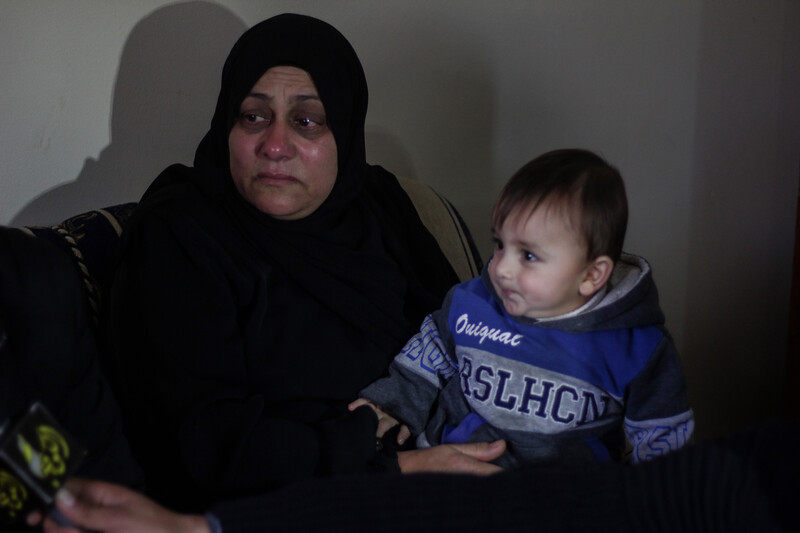The Electronic Intifada 17 March 2020

Mervat al-Naem holds up a picture of her son Muhammad.
The Electronic IntifadaLike many other people in Gaza, Mervat al-Naem watched a horrific video on 23 February. It showed Israeli soldiers crushing a man who had already been wounded with a bulldozer, then turning over his body to confirm he was dead.
Soon after she saw those images, Mervat learned that the victim was her youngest son Muhammad.
“When they told me it was Muhammad, I watched the video again,” she said. “I could feel every blow to his body. I still have a pain in my heart.”
Early that morning, Muhammad had brought his baby boy, Hamza, to the door of Mervat’s bedroom. Muhammad informed her that he had to go out but would be back before long.
“He waved, smiled and then he left,” Mervat said. It was the last time she saw him.
He was killed in the Khan Younis area, near the fence separating Gaza and Israel. Israel has alleged that he and another man tried to plant a bomb next to the fence.
In response to the killing, Islamic Jihad fired a number of rockets into Israel. The Israeli authorities then bombed Gaza repeatedly for two days.
Muhammad kept his involvement in armed resistance secret from his mother. She only learned about it when Islamic Jihad published a tribute to him on the day he was killed.
While Mervat said that she was surprised to learn her son was an Islamic Jihad fighter, she added that joining a resistance group “is normal in a place like Gaza.”
“Shooting at everyone”
Muhammad’s life had been shaped by Israeli brutality. He was only a teenager when Israel imposed a full blockade on Gaza in 2007; since then he had survived three major Israeli attacks on the Strip.
The video of Muhammad’s killing was made by Muthana al-Najjar, a journalist.
Muthana al-Najjar insists that Muhammad and another man were approximately 200 meters away from the boundary fence when they were injured by Israeli troops. His testimony contradicts Israel’s allegations that the men had planted an explosive device at the fence.
“The driver [of the bulldozer] wasn’t acting spontaneously,” said Muthana al-Najjar. “It was like an organized military operation.”
According to Muthana al-Najjar, eight Israeli soldiers “were shooting at everyone who approached the two men.” A drone flew above the men at low altitude.
Rich Gal, a senior figure in the Israeli military’s Horev Brigade, has been identified as the commander on the scene at the time of the killing.
Head “shattered”
Muhammad al-Naem had been fired on and badly wounded by the Israeli military before he was run over with a bulldozer.
A number of Palestinians had attempted to rescue him after he was initially struck. The cousins, Muhammad and Ahmad al-Najjar, were among those who tried to help.
They reached Muhammad al-Naem and lifted him on to a stretcher. Israeli soldiers fired toward the cousins as they did so.
Muhammad al-Najjar was shot in the legs with live ammunition and was taken to hospital, where he underwent surgery.
He recalled that Muhammad al-Naem had been seriously injured by the shelling. “When we carried al-Naem [on the stretcher], his intestines were leaking from his body,” Muhammad al-Najjar said. “His head had also been shattered. We could not carry him far because the bulldozer was speeding toward us and the soldiers were shooting a lot.”
Another man, Muhammad Abu Zur, tried to rescue Muhammad al-Naem by grabbing him by the hand as the bulldozer approached.
“I was the last person to touch al-Naem,” said Abu Zur. “When I grabbed his hand, the bulldozer went faster and lifted him up.”
Attack on human dignity
In a detailed analysis, a number of Palestinian human rights organizations found that the manner in which Muhammad al-Naem was killed and the way his body was abused amounted to a violation of human dignity. Such a violation is considered a war crime under the Rome State of the International Criminal Court.

Muhammad al-Naem had a baby son Hamza (pictured here with his grandmother).
The Electronic IntifadaAlthough the video of the killing has been widely shared and offers a stark example of Israeli cruelty, Muhammad’s wife Hiba has refused to look at it.
“My family told me how brutal the assassination was,” she said. “But I can’t watch my husband being torn apart. I hope this video disappears.”
Muhammad and Hiba had been married for 18 months. The 10-month-old baby Hamza was their only child.
Naftali Bennett, the Israeli defense minister, has expressed his support for Muhammad’s killing and for how the Israeli military has retained his corpse.
Israel’s defense ministry announced last year that the military would not return the bodies of Palestinian fighters when they are killed. Israel has reportedly introduced this policy to pressure Hamas into releasing the corpses of two Israeli soldiers who died while attacking Gaza.
The refusal to release Muhammad’s body has exacerbated the suffering of his family.
“I will need ages before I can forget the images of my son being killed,” said his mother Mervat. “All I wish for now is that his body will be handed back so that we can bury him.”
Hamza Abu Eltarabesh is a journalist from Gaza.





